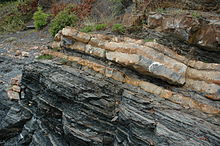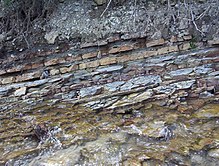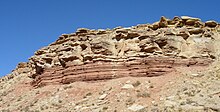Sediments and sedimentary rocks



In the geoscientific sense, sediments are various organic and / or mineral (inorganic) loose materials which - not infrequently after a shorter or longer transport by gravity or a flowing medium - are deposited (accumulate) on dry land or at the bottom of a body of water . Sedimentary rocks , deposit rocks or strata are more or less solid rocks that have emerged from such sediments through diagenesis over the course of geological time . Sediments and sedimentary rocks are divided into clastic , biogenic and chemical sediments .
education
Sedimentary rocks emerge from loose sediments through diagenesis . The increase in the lithostatic pressure as a result of the further overlaying with sediment as the sedimentation progresses leads to drainage and compression of the older, underlying sediment layers. It is not uncommon for a cement to precipitate from the remaining pore water in the further course of the diagenesis , which ultimately leads to the conversion of the compacted sediment into solid rock . The precipitated substance can be mobilized in the sediment itself (e.g. by pressure release on the contact surfaces of mineral grains) or it can have been brought in from a neighboring sediment. A special case of diagenesis is coalification , in which, as a result of the increase in pressure and temperature, volatile components of a predominantly organic sediment are deposited, as a result of which the non-volatile carbon remaining in the sediment is passively enriched.
properties
Sediments are stratified . A layer surface, the interface between two superimposed layers, is synonymous with the former sediment surface, which, depending on the depository, could have been the surface of the earth, the seabed or the bottom of a river or lake. Stratification can also arise afterwards during diagenesis .
One speaks of a sequence of layers when the resulting outcrop profile reveals several different rocks in their natural storage. (Compare also the banding of metamorphic rock .)
Sedimentary rocks are the only rocks that can contain fossils . Sedimentary rocks were also not exposed to high pressure or high temperature during their entire geological history (otherwise, depending on the degree of exposure and the associated change in the rock, one speaks of metasediments or orthogneiss ).
The sediment-forming processes are influenced by the effects of the earth's atmosphere , the hydrosphere and the biosphere on the surface of the solid earth. The sediment is shaped by the conditions under which it was formed. All environmental conditions that cause or influence the formation of a sediment are summarized under the term milieu , and the resulting sediment properties (including grain size, grain minerals, color, fossil content) are referred to as sedimentary facies . Milieu and facies are characteristic of different sedimentation areas and in practice the term facies is often equated with a specific deposit area (e.g. deep sea facies or fluvial facies).
Classification
In sedimentology there are various ways of categorizing sediments or sedimentary rocks.
According to the deposition environment or mechanism
-
Marine sediment :Rock material transportedfrom the land by rivers, glaciers, mass movements or wind into the sea is deposited on the sea floor in coastal areas , on the open shelf or the continental slope as well as on the floor of the deep sea or is formed by the activity of organisms living in the sea (for example Corals , foraminifera , diatoms ).
- Turbidite is the name for a deep marine sedimentary rock that has been deposited from a turbid flow
- Fluvial sediment : rivers deposit the crushed rock material carried along with them in the form of clay , silt , sand or gravel ,depending on the flow speed.
-
Glacial sediment : rock material transported by the glacial ice is deposited in the form of moraines or till; Individual blocks remain as boulders .
- Fluvioglacial sediment : Meltwater transports rock debris and glacial milk from the glacier and deposits it in large sand areas in front of it.
- Aeolian sediment : Particles transported by the wind are deposited in the form of dunes or loess blankets .
- Limnic sediment: In standing water, especially in lakes , store, depending on the lake fine-grained or very organic sediments, often called muds , from.
- Pyroclastic sediment from volcanism
- Micrometeorites form thick layers of sediment on celestial bodies that are free of atmosphere, but make only a negligible contribution to the formation of sedimentary rocks on Earth.
According to the origin
Clastic sediments
Clastic sedimentites (from the Greek κλαστός klastós “broken into pieces”), detritic sedimentites or rubble rocks are sedimentary rocks whose material mainly comes from the mechanical destruction of other rocks. In principle, it is irrelevant to which rock class ( magmatites , sedimentites, metamorphic rocks ) these parent rocks belonged. The geographical region in which the parent rocks are suspected or in which they are still detectable today is called the delivery area .
Various names are used for the fragments of the clastic sediments. If they are smaller than 0.002 mm, they are referred to as particles . Particles are so small that they cannot have arisen from the mechanical destruction of solid rock. Instead, they arise through the chemical conversion of certain minerals (e.g. feldspars and mica ) into clay minerals or through the erosion of unconsolidated material that was already present in particle size.
If the fragments are larger than 0.002 mm, they are summarized under the generic term clasts or grains . However, the term “clast” in sediment petrography is often only used for larger, macroscopically clearly recognizable fragments in an otherwise rather fine-grained sedimentary rock (although not every rock containing such clasts has to be a clastic sediment). Particularly large clasts or grains are called pebbles if they are at least slightly rounded and fragments if they show no signs of rounding. The total amount of grains of a certain grain size in a rock is called a fraction . The grain fractions that dominate the sediment or sedimentary rock are named, for example as gravel or conglomerate , sand or sandstone, or clay or mudstone (see → Classification according to grain size ).
Material and binder:
The mineral grains and rock fragments that make up the clastic sedimentary rocks hold together with the help of a primary or secondary binder.
- The primary binder is known as the matrix and usually consists of either clay particles or microscopic calcium carbonate particles that are deposited together with the coarser sediment components. However, the matrix only develops a binding effect after the sediment has been dewatered to a certain extent.
- The secondary binder is only created after the sediment has been deposited by chemical precipitation and is known as cement . This can be calcareous cement (calcium carbonate, CaCO 3 ), "pebbly" cement ( silicon dioxide , SiO 2 ), secondary ( authigenic ) clay minerals or oxides and hydroxides of iron (e.g. hematite , goethite ).
Depending on which minerals the grains and rock fragments of a clastic sedimentary rock consist of, different groups and subgroups can be distinguished. For example
- silicicoplastics consist mainly of silicate minerals such as quartz or feldspar. They are by far the most important group of clastic sedimentary rocks.
- One speaks of an arkosis if a siliciclastic sandstone contains significant amounts of minerals other than quartz (especially feldspars), in the case of a broad spectrum of minerals and other rock fragments as well as a matrix consisting of mica and clay minerals of a greywacke .
Chemical sediments
Chemical sediments arise from the precipitation of dissolved substances from oversaturated solutions. By evaporation z. B. the evaporites ( sulfates , such as gypsum or anhydrite , and halides , such as halite or potassium salts ). The Zechstein series in Central Europe is an example of a sequence with mighty evaporite stores. Also carbonates may arise that way. But they are not part of the evaporites.
Another possibility for the precipitation of carbonates is to increase the water temperature (in contrast to e.g. halite, carbonate dissolves better in cold than in warm water). In this way, spring limes form in areas with a relatively high proportion of limestone in the subsoil (see also → Karst ).
The precipitation of carbonates can also take place indirectly through living beings. Algae carry out photosynthesis and remove carbon dioxide from the water . As a result, carbon dioxide is split off from the hydrogen carbonate ions contained in the water , whereupon the latter usually with calcium ions according to the reaction equation
react to poorly soluble calcium carbonate.
Biogenic sediments

Biogenic sediments are formed by the activities of living organisms as well as from the remains of dead organisms. This includes the active excretion of mineral substances (usually carbonate or phosphate skeletons), which can accumulate to form more or less thick sediment packages, such as reef limestone , mud mounds or bone beds . The massive limestone deposits of the Cretaceous period often consist largely of extremely small calcium carbonate skeletons of algae (→ nannoplankton ). Even non-mineral residues of dead organisms can form larger sediment bodies, e.g. B. peat or coal , which arise from the accumulation and transformation of dead plant remains.
Residual rocks
Residue rocks or Residualgesteine are no sedimentary rocks in the true sense. They arise through chemical weathering and represent the remainder of the parent rock , which is chemically stable under the prevailing conditions. Typical residual rocks are gypsum cap (e.g. Central Europe) and saprolite (tropics). Secondary precipitation of oxidic iron, aluminum or silicon compounds from aqueous weathering solutions in the pore space of residual rocks and soils are sometimes regarded as chemical sediments. However, since they are related to immediately preceding chemical weathering processes, they are better to address as soil formations (see also → Duricrust ).
According to grain sizes
Clastic loose sediments are named after the grain size of the majority of the sediment particles represented in them as clay , silt (silt), sand or gravel . Water-saturated loose sediments with a predominant proportion of grain sizes below that of sand are summarized under the term sludge , but not every sludge is a clastic sediment. Loose sediments with coarse and very coarse grain sizes, such as gravel, bricks and blocks are called in rounded "grains" scree and edged "grains" debris .
The following names for the sedimentary rocks that emerged from loose sediments are also largely based on the prevailing grain size:
- Conglomerate or breccia with grain sizes larger than 2 mm. Conglomerates consist of rounded, breccias of angular rock debris.
- Sandstone consists mainly of grains with a grain size of 0.063 to 2 mm.
- Schluffstein (or siltstone) consists predominantly of grains that are between 0.002 and 0.063 mm in size.
- Claystone contains mostly particles that are smaller than 0.002 mm (2 µm).
Under these rock names, however, mainly siliciclastic sedimentary rocks are understood, i. that is, they also contain a statement about the material of which the grains and particles are made. An older classification also relates primarily to siliciclastic rocks, with the names Psephit for rocks with large grain sizes, Psammite for rocks with medium-sized grains and Pelit for rocks with the smallest grain sizes. Only the latter term is still used regularly today.
Another, but more neutral, classification based on the grain size distinguishes lutite (smaller than 2 µm), siltite (between 2 µm and 0.063 mm), arenite (between 0.063 and 2 mm) and rudite (larger than 2 mm). It is used with the addition of "limestone" in the classification of (clastic) carbonate rocks.
meaning
Many sedimentary rocks are used economically (e.g. limestone in the construction industry). In certain sediments can oil and natural gas produced ( petroleum source rock ), which then in a petroleum storage rock emigrate ( migrate ) to. Hard coal and lignite are also sedimentary rocks of great (albeit dwindling) economic importance.
Sedimentary rocks (especially limestone and dolomite ) can contain large amounts of carbonate , which requires carbon dioxide to form . Compared to the atmospheres of Venus or Mars , for example , where these sediments do not or hardly occur, the proportion of carbon dioxide in the earth's atmosphere is extremely low.
The study of sedimentary rocks enables, among other things, the structures, minerals and fossils they contain to reconstruct habitats that existed before geological times.
See also
literature
- Hans Füchtbauer (Ed.): Sediments and Sedimentary Rocks (= Sediment Petrology. Volume 2). 4th, completely revised edition. Schweizerbart'sche Verlagbuchhandlung, Stuttgart 1988, ISBN 3-510-65138-3 .
- Walter Maresch, Olaf Medenbach: Rocks. Steinbach's nature guide. Mosaik-Verlag, Munich 1996, ISBN 3-576-10699-5 .
- Roland Vinx: Rock determination in the field. 4th edition, Springer-Verlag, 2015, ISBN 978-364255418-6 , pp. 265–351.

